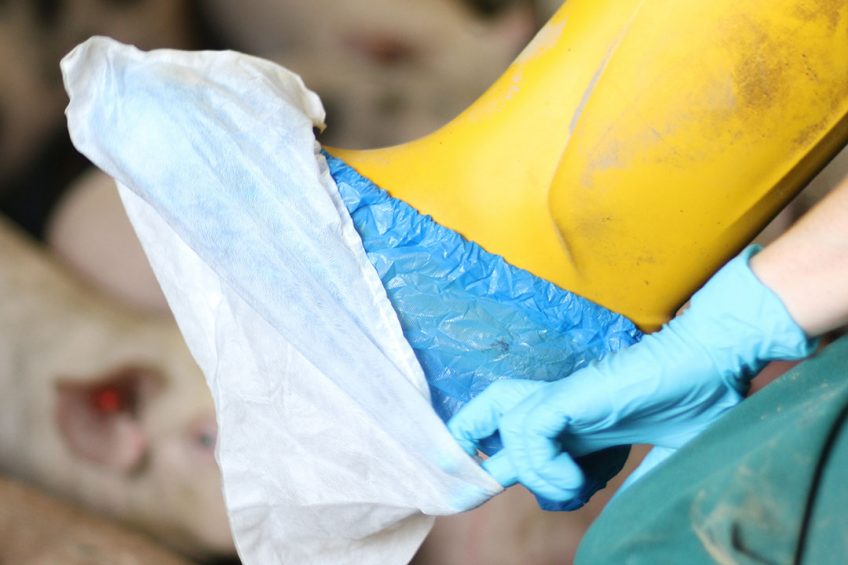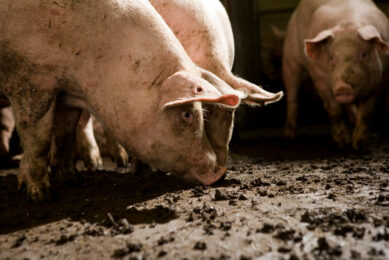Overcoming Salmonella: Do vaccination or probiotics help?

Ideally, Salmonella infections should not normally happen. But the bacteria does occur in pig herds, which might lead to human cases of gastroenteritis (via direct/indirect contact, environmental contamination or foodborne infections). Are there ways to control Salmonella infections in pigs, using vaccination or probiotics? A recent PhD study investigated these options.
Infections with Salmonella Typhimurium in pigs constitute a major risk for human salmonellosis. It is estimated that, worldwide, each year 93.8 million human cases of gastroenteritis caused by Salmonella species occur. In the EU and Belgium, in 2017, the number of reported confirmed human salmonellosis cases was 91,662 and 2,344, respectively.
Since not every infection is officially reported, these numbers are considered to be an underestimation of the actual number of human salmonellosis cases. It is estimated that 41.5% of the true human salmonellosis cases (i.e. estimated number of cases when accounting for underestimation) in the EU were attributable to pigs. Most Salmonella infections in humans are considered foodborne, emphasising the importance of the food safety of pork products.
In Europe, Salmonella is considered a problem, but each country differs in how monitoring is addressed. Table 1 summarises how Salmonella in pigs is being tackled in 4 European countries.
All stages should be targeted
According to the “farm-to-fork” or “stable-to-table” approach, all stages in the swine production chain, i.e. pre-harvest, harvest and post-harvest, should be targeted to reduce the potential risk of Salmonella. The thesis focused on pre-harvest control measures against Salmonella Typhimurium infections in pigs. There are several risk factors for Salmonella infections in swine, but there are also several on-farm control measures that may help to reduce Salmonella prevalence in primary production, as well as further along the swine production chain.
In the research carried out at Ghent University, Belgium, the emphasis was on vaccination with an attenuated vaccine and the application of a probiotic feed additive. The general aim was to provide scientific evidence that could be used to optimise the control of Salmonella Typhimurium infections at farm level.
2 general research questions were formulated:
- Can vaccination with an attenuated Salmonella Typhimuriumvaccine be used to optimise the control of Salmonella Typhimurium infections at farm level?
- Can the application of Clostridium butyricum as a probiotic feed additive be used to optimise the control of Salmonella Typhimurium infections at farm level?
Vaccination
The attenuated histidine-adenine auxotrophic vaccine Salmoporc (IDT Biologika) is currently the only Salmonella Typhimurium vaccine commercially available for pigs in Europe. Therefore, this was the attenuated vaccine under investigation in this thesis.
The research evaluated the application of several different vaccination protocols in one farrowing batch and compared these to a non-vaccinated control group in 3 subclinically infected pig herds during 2 consecutive production cycles.
The protocols included:
- Vaccination of sows;
- Vaccination of sows and piglets;
- Vaccination of sows and fattening pigs;
- Vaccination of piglets; and
- Vaccination of fattening pigs.
Vaccination and bacterial prevalence
Attention was paid to the effect of the different vaccination protocols on Salmonella bacteriology (prevalence in faecal and overshoe samples and in ileocecal lymph nodes at slaughter), and on the daily weight gain during the fattening period. The prevalence of Salmonella Typhimurium field strain excretion was low; in total, 4% of the faecal and overshoe samples collected in the non-vaccinated control group were Salmonella Typhimurium field strain positive. No significant differences were detected between farms, production cycles and experimental groups regarding the excretion of Salmonella Typhimurium field strain.
In the second production cycle, compared to the non-vaccinated control group, a protective effect of vaccination on the number of Salmonella Typhimurium field strain positive lymph nodes was detected when applying vaccination either in sows and piglets, sows and fattening pigs or in piglets only. In the first production cycle, this protective effect was absent.
Vaccination of sows and piglets resulted in the most consistent reduction of Salmonella Typhimurium field strain positive lymph nodes at slaughter. The vaccine strain was detected in samples collected in the sows as well as in the growing and fattening pigs and in the lymph nodes of 13 pigs at slaughter, indicating the possible persistence of the vaccine strain until slaughter.

Vaccination and serology
The next point of attention was the effect of the different vaccination protocols on Salmonellaserology. Vaccination of sows induced a serological response and increased the level of maternally derived antibodies in 3-day-old piglets. Also, a significant correlation between the serological results in sows and their offspring was present, indicating the transfer of maternal antibodies by the sow colostrum. Slaughter pigs that had been vaccinated either as piglets or as fattening pigs had significantly higher sample/positive (S/P) ratios than non-vaccinated pigs. The S/P ratios in unvaccinated pigs from vaccinated sows (experimental group 1) were not significantly different from S/P ratios in non-vaccinated pigs at slaughter. These results suggested that vaccination of piglets and fattening pigs could interfere with currently used serology-based Salmonellamonitoring programmes in slaughter pigs.
Effect of group vaccination
The effect of group vaccination of all sows and gilts against Salmonella Typhimurium was evaluated and compared to data historically collected on 3 subclinically infected pig herds. The effect on Salmonella bacteriology (prevalence in faecal and overshoe samples and in ileocecal lymph nodes at slaughter), and on Salmonella serology in the sows and their offspring was described. The group vaccination of sows and gilts induced a serological response in sows and resulted in significantly lower S/P ratios in their offspring at slaughter age, which might result in a more beneficial serological status of the offspring in the currently used serology-based Salmonella monitoring programmes in slaughter pigs. Yet, the excretion of Salmonella Typhimurium in the sows and their offspring and the prevalence of Salmonella Typhimurium positive lymph nodes in the offspring were not significantly decreased.
Probiotic feed additive
The efficacy of C. butyricum as a probiotic feed additive against Salmonella Typhimurium infection in experimentally challenged pigs was also evaluated in this thesis. By fermenting dietary fibre, C. butyricum is known to produce butyrate, which is an important energy source for intestinal epithelial cells. Additionally, butyrate can downregulate the expression of several genes of Salmonella. That finding resulted in the speculation that the modification of gut flora to produce more butyric acid (e.g. by probiotics) could reduce invasive infections by Salmonella in farm animals.
The main focus of this part of the study was to measure the effect of the application of C. butyricum as a probiotic feed additive on Salmonellabacteriology (faecal excretion, intestinal carriage, and prevalence in ileocecal lymph nodes), Salmonella serology, and the performance of the pigs. Under the evaluated conditions, the probiotic feed additive C. butyricum did not significantly reduce faecal excretion, serological response, intestinal carriage and prevalence of Salmonella Typhimurium in the ileocecal lymph nodes in experimentally challenged pigs.
Take home messages
The research provided evidence that vaccination with an attenuated Salmonella Typhimurium vaccine can support the control of Salmonella Typhimurium infections in subclinically infected pig herds. The vaccination of sows and piglets is the preferred vaccination protocol to reduce the prevalence of Salmonella Typhimurium field strain positive lymph nodes at slaughter, and provides future perspective, e.g. to be evaluated in large-scale field studies, vaccinating all sows, gilts and piglets on farms.
Based on the results of the experimental study performed in the current thesis, and on the available literature, it is unclear if the application of C. butyricum as probiotic feed additive is efficacious to reduce Salmonella Typhimurium prevalence in pigs under field conditions. Further research under field conditions is necessary.
This article is an approved and edited summary of the PhD thesis “On-farm control measures against Salmonella Typhimurium infections in pigs”.
More information: editors@gdanimalhealth.com












